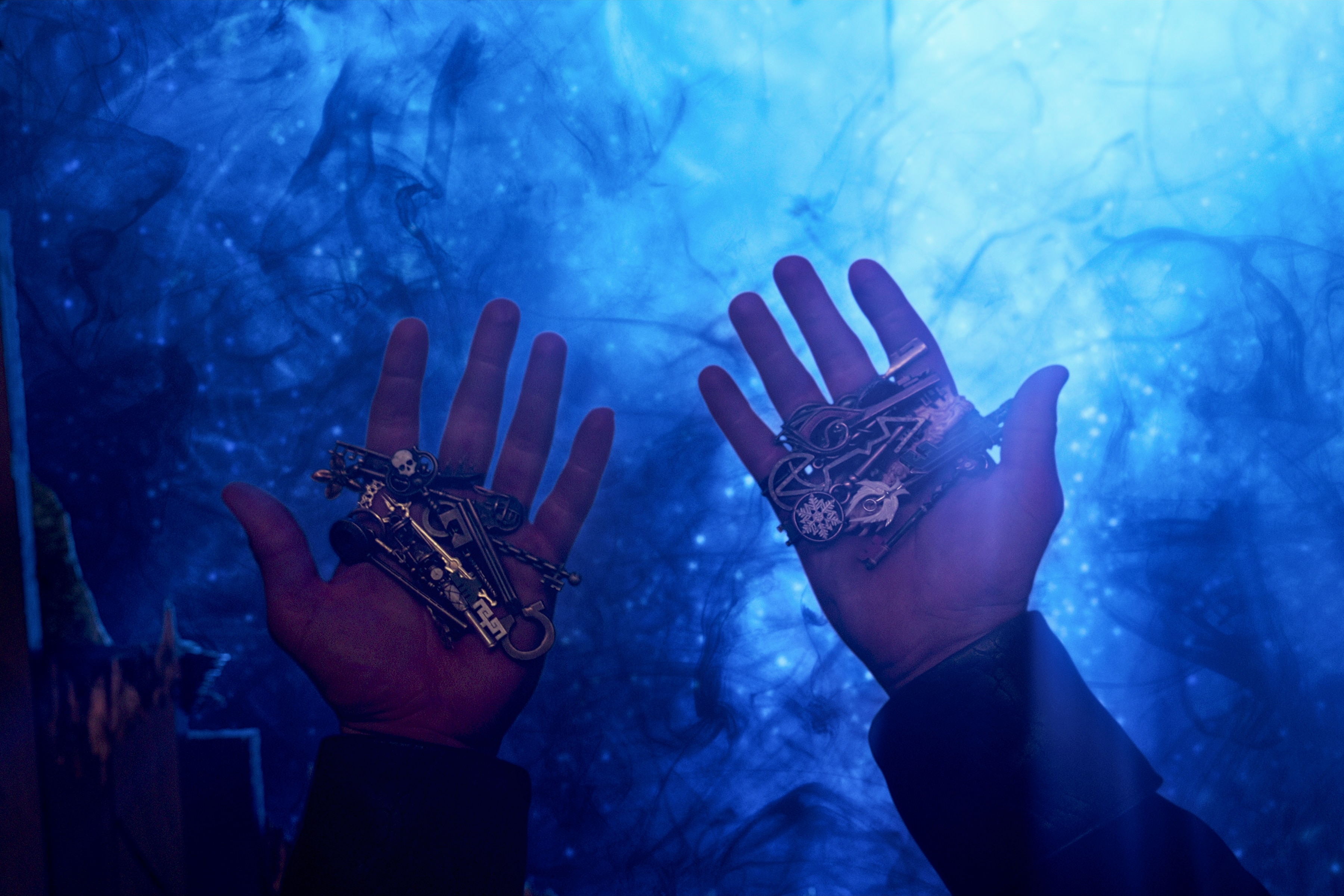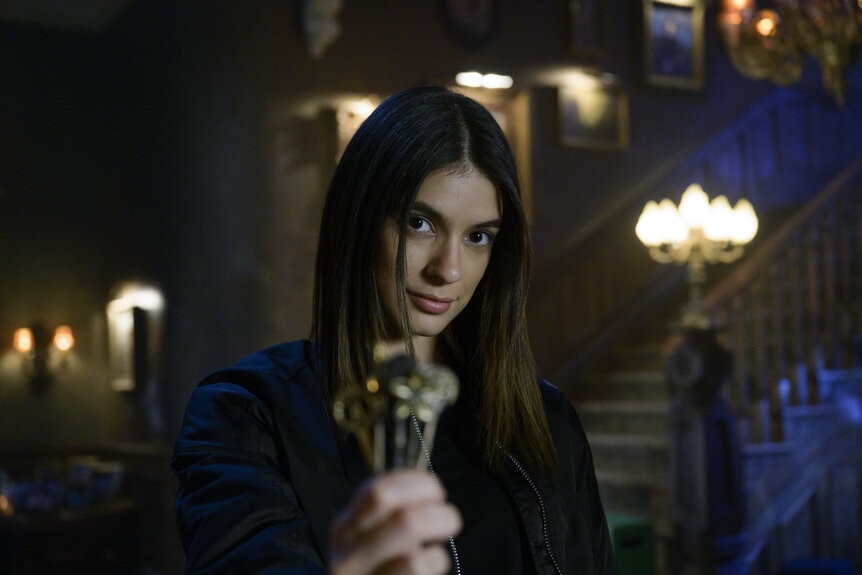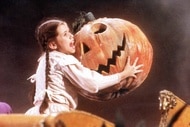Create a free profile to get unlimited access to exclusive videos, sweepstakes, and more!
'Locke and Key': A final season guide to all the magical keys on the Netflix series
Time to unlock the third and final season of Locke & Key, now streaming on Netflix.

Locke and Key's third and final season is out on Netflix now, and with it comes a whole host of keys for the Locke kids to stumble upon and grapple over — as well as a whole new world of trouble. And while the television adaptation of Joe Hill (Horns) and Gabriel Rodriguez’s popular comic book series of the same name has introduced many of the keys from the pages of the comics into the world of the show, it’s also taken a stab at creating a few new ones.
"It's an intuitive process for us," co-creator Carlton Cuse explained to SYFY WIRE last year. "There are certain keys in the comics that we love that we knew we wanted to get to. [co-creator Meredith Averill and I] also had a lot of conversations between ourselves and with the other writers about what keys we might want to see in this house and what we would imagine being there that would be really cool."
With the doors of Keyhouse open once again, here are just some of the keys that have been unlocked thus far...
The Anywhere Key
This first-ever key introduced within the show is also undoubtedly one of its most powerful ones. It allows the user to travel anywhere in the world — as long as they’ve seen the door they want to travel through. While Bode uses it to visit the Matheson ice cream parlor, Dodge (AKA the demonic being seeking to control all the keys) uses it to travel around the world, commit murder, and free Scott Lesser (one of the series’ lesser, human villains) in her bid to further antagonize the Locke family.
The Mirror Key
The second key that Bode Locke discovers is one entirely made up for the show, but it serves a few important purposes, beyond being completely chill-inducing. Not only does it bring your reflection to life in the mirror (creepy smile reflection included), but it also seems to beckon the user into its mirror world so it can trap them there in a sort of Prison of the Self, with seemingly no way out until someone else comes to the rescue. As is the case when Nina gets trapped in there, and her son Tyler must go in after her. (It’s also important to note that this is one of the first instances in which we learn that key magic affects adults differently, as they seem to forget it exists unless they’re inebriated.)
The Matchstick Key
Like the name says, this key acts as a matchstick, allowing users to set fire to whichever location or thing they want, by simply striking the key against it like you would a real matchstick. It’s one of the few keys that doesn’t require a door or even a lock, and it’s useful in that it can be used tactically, like Bode does when he turns it into a weapon by sticking it in his broken toy lightsaber.
The Head Key
The key with the most iconic design — a key with a head for its “handle” — lets its user travel into a person’s mind and explore their feelings, their subconscious, and their memories. It also lets you store items within your mind, which means you could leave a whole textbook in there and suddenly gain its knowledge. Of course, like most of the other keys, it also comes with a few drawbacks, as not only do users run the risk of being trapped within their own minds, but memories can only be recalled as you experienced them, which means not everything you see is to be trusted.
The Ghost Key
This key allows the user to leave their physical form and exist solely as a spirit, undetectable to human senses. But while this allows for plenty of opportunities to spy on other people, it also comes with some very big caveats. The first is that it can only ever be used on one door in Keyhouse, and that it must remain open the whole time the spirit and the body have been separated because if it shuts you’ll be trapped indefinitely — appearing dead to whoever finds you. (Bode describes the body as being like a sock without a foot.)
The Music Box Key
Not only does this key activate a magical music box, but it allows its wielder to turn another person into their puppet by controlling their entire body. Granted, much like the rules around the Anywhere Key, the person being controlled must actually hear the music playing. Kinsey goes from using it to tell Tyler to shut up (an order he cannot negate no matter how much he struggles) to using it to teach a school bully a lesson.
The Plant Key
This key doesn’t feature in the comics that much, but within the show, we learn that the key activates a tree that has the kids’ uncle (and their father’s brother) Duncan Locke’s memories stored in its roots. Upon further investigation, they learn that this is why he cannot remember certain instances from his youth. In order to store the memory, it must be taken from him fully, leaving him hazy when he tries to recall it.
The Identity Key
Perhaps the most pivotal key of all, this one allows the user to change their appearance, and change that of others as well. Dodge uses it to get closer to the Locke family and eventually trick them a few different times. The person using the key can transform into someone of a different gender, race, age, and even weight, meaning its capacity for chaos is endless. (In the comics, this is known as the “Gender Key,” but the show appears to have enhanced its ability.)
The Mending Key
This one works in tandem with the Mending Cabinet, as broken objects must be locked inside, so they can be fixed and once again emerge whole again. Sadly, this does not work on dead people, as Nina learns when she places the remains of her dead husband Rendell in there. This is one of the more straightforward keys so far, but perhaps it will have more narrative significance going forward.
The Omega Key
This powerful key opens the Black Door, a portal to another realm, where parasitic demonic beings exist. And while they can travel through into our world, they require a host to keep living here, so combust pretty quickly upon crossing over, eventually cooling into a kind of “whispering” iron. The original “Keepers of the Keys” (Rendell Locke and his friends) first found the Omega Key and opened the Black Door, thus unleashing Dodge into our world.)
The Echo Key
Ellie Whedon steals and secretly uses this key, which reveals its horrifying ability to bring people back from the dead… but as a former shadow of themselves, aka an “echo.” In this case, the person it brings back returns corrupted by one of the demonic forces behind the Omega Door, which only causes more problems for everyone involved. However, there is some (slightly) good news: any person brought back can only remain in the well house and never really travel outside its bounds. Of course, this changes if the person is in possession of the Anywhere Key, as that would allow them to travel outside and anywhere they want.
The Shadow Key
This must be placed in the Crown of Shadows, which then allows the wearer to control a host of shadow monsters, with all of them taking whatever shape the wearer wishes them to. However, seeing as they are still made of shadows at the end of the day, any source of light quickly destroys them.
The Timeshift Key
The most recent trailer for Season 3 unlocked the power of time travel with the aptly-named Timeshift Key. Bode's use of this temporal door-opener thrusts him back in time to the 18th century, where he meets with his ancestor, Benjamin Locke.
The Bestiary Key
Like the Timeshift Key, the Animal Key is pretty self-explanatory: it turns the user into an animal! More specifically, however, it is said to unleash one's "inner animal."
The Snow Globe Key
Christmas in August? Why the heck not?! Recalling Charlie Manx's sinister Christmasland of Joe Hill's NOS4A2, this key opens a portal to a snowy paradise...hopefully one without all the soulless children.
Season 3 of Locke and Key drops today on Netflix.
Additional reporting by Josh Weiss

























